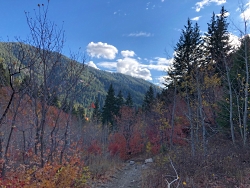
Courtesy and Copyright Matthew Wickenhiser, Photographer
Solitude, awe, beauty…breeze, trees, birds…life.

Hold on. Happiness is not a simple thing to achieve or understand. Sources are both internal and external. But for this story we are focusing on the happiness which comes from being in a mentally beneficial environment. Utah’s incredibly diverse landscape lends itself to be adaptably beneficial to a population of various preferences. It quite literally can suit just about anyone’s partialities. Whether someone likes mild winters in the desert or harsh, bitter, white winters, (which most people on this plant have only heard about in stories) Utah has it all. If someone prefers quiet towns or large and bustling urban centers, thinner air to thicker air; Utah can accommodate. But what do these accommodations have to do with happiness?
There is an ever-growing expanse of research regarding the mental health benefits of nature. Much of this research came about after the establishment of wilderness therapy programs which began to take root in Utah during the latter part of the 1980s. Griffin Woods, a student at Utah State University, experienced one of these wilderness programs. One of the important things he said about experiencing nature was, “People should definitely be pushed more to go outside, get off the phone and be in nature as opposed to being glued to a phone.” (Griffin. Personal communication. October 2019)
This happiness can spread to family members. Many children who participate in an outdoor education program will afterwards ask their parents to take them out into nature so they could “show and tell” them what they have seen and heard.

Courtesy and Copyright Matthew Wickenhiser, Photographer
So, this, this is what makes Utah so incredible. This state’s unique ability to make its residents and visitors happier. All you have to do is get outside. We end with this quote from Edward Abbey, “Wilderness is not a luxury but necessity of the human spirit.” So please, feed your spirit, enrich your soul, and enlighten your mind. You exist in arguably one of the most perfect places in the world to do this. Now go be Wild About Utah.
This is Matthew Wickenhiser and I’m Wild About Utah.
Credits:
Photos: Courtesy & Copyright © Matthew Wickenhiser
Additional audio provided by Friend Weller and Kevin Colver
Text: Matthew Wickenhiser, Utah State University
Additional Reading
Utah Travel Industry Website https://www.utah.com/
Utah, History.com, A&E Television Networks, Nov 9, 2009, https://www.history.com/topics/us-states/utah
Utah: A Geologic History – Utah Geological Survey, Department of Natural Resources, State of Utahhttps://www.history.com/topics/us-states/utah
Utah Forest Overview, USDA Forest Service, https://www.fs.fed.us/rm/ogden/overviews/Utah/OV_Utah.htm
These 20 Utah Landscapes Will Blow You Away With Their Beauty, https://www.onlyinyourstate.com/utah/20-ut-landscapes/
